Synthesizing a Regional Territorial Evapotranspiration Dataset for Northern China
Abstract
1. Introduction
2. Study Area and Data
2.1. Study Area
2.2. Data
2.2.1. Evapotranspiration
2.2.2. ET Tower Observation Data
2.2.3. Auxiliary Data
3. Method
3.1. Assessment Method
3.2. Synthesis and Validation Method
4. Results
4.1. Assessment of ET Products from Different Perspectives
4.1.1. Assessment with All Sites’ Monthly ET
4.1.2. Assessment by Land Cover Type
4.1.3. Assessment by Climatic Zones
4.1.4. Assessment by Elevation Levels
4.2. Overall Assessment Result
4.3. Synthesis Result
4.4. Assessment of the Synthesized ET Dataset
5. Discussion
6. Conclusions
Author Contributions
Funding
Data Availability Statement
Acknowledgments
Conflicts of Interest
References
- Jung, M.; Reichstein, M.; Ciais, P.; Seneviratne, S.I.; Sheffield, J.; Goulden, M.L.; Bonan, G.; Cescatti, A.; Chen, J.; De Jeu, R. Recent decline in the global land evapotranspiration trend due to limited moisture supply. Nature 2010, 467, 951–954. [Google Scholar] [CrossRef]
- Scott, R.L.; Biederman, J.A. Partitioning evapotranspiration using long-term carbon dioxide and water vapor fluxes. Geophys. Res. Lett. 2017, 44, 6833–6840. [Google Scholar] [CrossRef]
- Mccoll, K.A. Practical and theoretical benefits of an alternative to the Penman-Monteith evapotranspiration equation. Water Resour. Res. 2020, 56. [Google Scholar] [CrossRef]
- Wilson, K.B.; Hanson, P.J.; Mulholland, P.J.; Baldocchi, D.D.; Wullschleger, S.D. A comparison of methods for determining forest evapotranspiration and its components: Sap-flow, soil water budget, eddy covariance and catchment water balance. Agric. For. Meteorol. 2001, 106, 153–168. [Google Scholar] [CrossRef]
- Lawrence, D.M.; Thornton, P.E.; Oleson, K.W.; Bonan, G.B. The partitioning of evapotranspiration into transpiration, soil evaporation, and canopy evaporation in a GCM: Impacts on land–atmosphere interaction. J. Hydrometeorol. 2007, 8, 862–880. [Google Scholar] [CrossRef]
- Jasechko, S.; Sharp, Z.D.; Gibson, J.J.; Birks, S.J.; Yi, Y.; Fawcett, P.J. Terrestrial water fluxes dominated by transpiration. Nature 2013, 496, 347–350. [Google Scholar] [CrossRef]
- Zhang, K.; Kimball, J.S.; Nemani, R.R.; Running, S.W. A continuous satellite-derived global record of land surface evapotranspiration from 1983 to 2006. Water Resour. Res. 2010, 46. [Google Scholar] [CrossRef]
- Liu, W.; Wang, L.; Zhou, J.; Li, Y.; Sun, F.; Fu, G.; Li, X.; Sang, Y.-F. A worldwide evaluation of basin-scale evapotranspiration estimates against the water balance method. J. Hydrol. 2016, 538, 82–95. [Google Scholar] [CrossRef]
- Calanca, P.; Roesch, A.; Jasper, K.; Wild, M. Global warming and the summertime evapotranspiration regime of the Alpine region. Clim. Chang. 2006, 79, 65–78. [Google Scholar] [CrossRef]
- Ruhoff, A.L.; Paz, A.; Aragao, L.; Mu, Q.; Malhi, Y.; Collischonn, W.; Rocha, H.; Running, S.W. Assessment of the MODIS global evapotranspiration algorithm using eddy covariance measurements and hydrological modelling in the Rio Grande basin. Hydrol. Sci. J. 2013, 58, 1658–1676. [Google Scholar] [CrossRef]
- Xue, B.-L.; Wang, L.; Li, X.; Yang, K.; Chen, D.; Sun, L. Evaluation of evapotranspiration estimates for two river basins on the Tibetan Plateau by a water balance method. J. Hydrol. 2013, 492, 290–297. [Google Scholar] [CrossRef]
- Tasumi, M. Estimating evapotranspiration using METRIC model and Landsat data for better understandings of regional hydrology in the western Urmia Lake Basin. Agric. Water Manag. 2019, 226, 105805. [Google Scholar] [CrossRef]
- Walker, E.; García, G.A.; Venturini, V.; Carrasco, A. Regional evapotranspiration estimates using the relative soil moisture ratio derived from SMAP products. Agric. Water Manag. 2019, 216, 254–263. [Google Scholar] [CrossRef]
- Boé, J.; Terray, L. Uncertainties in summer evapotranspiration changes over Europe and implications for regional climate change. Geophys. Res. Lett. 2008, 35. [Google Scholar] [CrossRef]
- Yin, Y.; Wu, S.; Zhao, D.; Zheng, D.; Pan, T. Modeled effects of climate change on actual evapotranspiration in different eco-geographical regions in the Tibetan Plateau. J. Geogr. Sci. 2013, 23, 195–207. [Google Scholar] [CrossRef]
- Pan, S.; Tian, H.; Dangal, S.R.; Yang, Q.; Yang, J.; Lu, C.; Tao, B.; Ren, W.; Ouyang, Z. Responses of global terrestrial evapotranspiration to climate change and increasing atmospheric CO2 in the 21st century. Earths Future 2015, 3, 15–35. [Google Scholar] [CrossRef]
- Dong, Q.; Wang, W.; Shao, Q.; Xing, W.; Ding, Y.; Fu, J. The response of reference evapotranspiration to climate change in Xinjiang, China: Historical changes, driving forces, and future projections. Int. J. Climatol. 2020, 40. [Google Scholar] [CrossRef]
- Anderson, M.C.; Kustas, W.P. Mapping Evapotranspiration and Drought at local to Continental Scales using Thermal Remote Sensing. In Proceedings of the IEEE International Geoscience & Remote Sensing Symposium, Boston, MA, USA, 7–11 July 2008. [Google Scholar]
- Yao, Y.; Liang, S.; Qin, Q.; Wang, K.; Zhao, S. Monitoring global land surface drought based on a hybrid evapotranspiration model. Int. J. Appl. Earth Obs. Geoinf. 2011, 13, 447–457. [Google Scholar] [CrossRef]
- Antofie, T.; Vogt, J.; Sepulcre-Canto, G.; Arboleda, A. Assessment of the EUMETSAT LSA-SAF evapotranspiration product for drought monitoring in Europe. Int. J. Appl. Earth Obs. Geoinf. 2014. [Google Scholar] [CrossRef]
- Morse, A. Satellite-Based Evapotranspiration by Energy Balance for Western States Water Management. In Proceedings of the Impacts of Global Climate Change, Anchorage, AK, USA, 15–19 May 2005. [Google Scholar]
- Hochmuth, H.; Thevs, N.; He, P. Water allocation and water consumption of irrigation agriculture and natural vegetation in the Heihe River watershed, NW China. Environ. Earth Sci. 2015, 73, 5269–5279. [Google Scholar] [CrossRef]
- Wu, B.; Zeng, H.; Yan, N.; Zhang, M. Approach for Estimating Available Consumable Water for Human Activities in a River Basin. Water Resour. Manag. 2018, 32, 2353–2368. [Google Scholar] [CrossRef]
- Mahmoud, S.H.; Yew, G.T. Irrigation water management in arid regions of Middle East: Assessing spatio-temporal variation of actual evapotranspiration through remote sensing techniques and meteorological data. Agric. Water Manag. 2019, 212, 35–47. [Google Scholar] [CrossRef]
- Davis, S.L.; Dukes, M.D. Irrigation scheduling performance by evapotranspiration-based controllers. Agric. Water Manag. 2010, 98, 19–28. [Google Scholar] [CrossRef]
- Huang, W.C.; Lee, J.L.; Tsai, A.Y. Impact of Evapotranspiration on Agricultural Water Resources under Climate Change. In Proceedings of the 2012 2nd International Conference on Environmental and Agriculture Engineering, Jeju Island, Korea, 29 June 2012. [Google Scholar]
- Baik, J.; Choi, M. Agricultural Water Management Evaluation of geostationary satellite (COMS) based Priestley–Taylor evapotranspiration. Agric. Water Manag. 2015, 159, 77–91. [Google Scholar] [CrossRef]
- Jamshidi, S.; Zand-Parsa, S.; Kamgar-Haghighi, A.A.; Shahsavar, A.R.; Niyogi, D. Evapotranspiration, crop coefficients, and physiological responses of citrus trees in semi-arid climatic conditions. Agric. Water Manag. 2020, 227. [Google Scholar] [CrossRef]
- Han, B.F.; Liu, Y.B. Impacts of different ecological restoration measurements on the evapotranspiration characteristics of the typical steppe in the loess hilly area of Ningixa. J. Agric. Sci. 2013, 4, 7–10. [Google Scholar]
- Lu, K.; Garcia, M.; Yu, J.; Zhang, Y.; Ping, W.; Sheng, W.; Xiao, L. Ecological restoration of groundwater-dependent vegetation in the arid Ejina Delta: Evidences from satellite evapotranspiration. In Proceedings of the 19th EGU General Assembly, EGU2017, Vienna, Austria, 23–28 April 2017. [Google Scholar]
- Scott, S.; Si, Z.; Schumilas, T.; Chen, A. Organic Food and Farming in China: Top-Down and Bottom-Up Ecological Initiatives; Routledge: Abingdon, UK, 2018. [Google Scholar]
- Qiu, G.Y.; Jin, Y.; Geng, S. Impact of Climate and Land-Use Changes on Water Security for Agriculture in Northern China. J. Integr. Agric. 2012, 11, 144–150. [Google Scholar] [CrossRef]
- Oki, T.; Kanae, S.; Musiake, K. Global Hydrological Cycles and World Water Resources. Science 2006, 313, 1068–1072. [Google Scholar] [CrossRef] [PubMed]
- Bowen, I.S. The Ratio of Heat Losses by Conduction and by Evaporation from any Water Surface. Phys. Rev. 1926, 27, 779. [Google Scholar] [CrossRef]
- Monteith, J.; Unsworth, M. Principles of Environmental Physics, 4th ed.; Elsevier: Amsterdam, The Netherlands, 2008. [Google Scholar]
- Allen, R.G. Lysimeters for evapotranspiration and environmental measurements. In Proceedings of the International Symposium on Lysimetry, Honolulu, HI, USA, 23–25 July 1991. [Google Scholar]
- Ran, Y.; Li, X.; Kljun, N.; Sun, R.; Zhang, L. Spatial Representativeness and Uncertainty of Eddy Covariance Carbon Flux Measurement for Upscaling Net Ecosystem Productivity to Field Scale. In Proceedings of the Agu Fall Meeting, San Francisco, CA, USA, 14–18 December 2015. [Google Scholar]
- Herman, M.R.; Nejadhashemi, A.P.; Abouali, M.; Hernandez-Suarez, J.S.; Daneshvar, F.; Zhang, Z.; Anderson, M.C.; Sadeghi, A.M.; Hain, C.R.; Sharifi, A. Evaluating the role of evapotranspiration remote sensing data in improving hydrological modeling predictability. J. Hydrol. 2018, 556, 39–49. [Google Scholar] [CrossRef]
- Li, Z.-L.; Tang, R.; Wan, Z.; Bi, Y.; Zhou, C.; Tang, B.; Yan, G.; Zhang, X. A Review of Current Methodologies for Regional Evapotranspiration Estimation from Remotely Sensed Data. Sensors 2009, 9, 3801–3853. [Google Scholar] [CrossRef] [PubMed]
- Zhang, Y.; Kong, D.; Gan, R.; Chiew, F.H.S.; McVicar, T.R.; Zhang, Q.; Yang, Y. Coupled estimation of 500m and 8-day resolution global evapotranspiration and gross primary production in 2002–2017. Remote Sens. Environ. 2019, 222, 165–182. [Google Scholar] [CrossRef]
- Chen, X.; Su, Z.; Ma, Y.; Yang, K.; Wen, J.; Zhang, Y. An Improvement of Roughness Height Parameterization of the Surface Energy Balance System (SEBS) over the Tibetan Plateau. J. Appl. Meteorol. Climatol. 2013, 52, 607–622. [Google Scholar] [CrossRef]
- Senay, G.B.; Bohms, S.; Singh, R.K.; Gowda, P.H.; Velpuri, N.M.; Alemu, H.; Verdin, J.P. Operational evapotranspiration mapping using remote sensing and weather datasets: A new parameterization for the SSEB approach. J. Am. Water Resour. Assoc. 2013, 49, 577–591. [Google Scholar] [CrossRef]
- Mu, Q.; Zhao, M.; Running, S.W. Improvements to a MODIS global terrestrial evapotranspiration algorithm. Remote Sens. Environ. 2011, 115, 1781–1800. [Google Scholar] [CrossRef]
- Cosgrove, B.A. Land surface model spin-up behavior in the North American Land Data Assimilation System (NLDAS). J. Geophys. Res. 2003, 108, 8845. [Google Scholar] [CrossRef]
- Miralles, D.G.; Holmes, T.R.H.; De Jeu, R.A.M.; Gash, J.H.; Meesters, A.G.C.A.; Dolman, A.J. Global land-surface evaporation estimated from satellite-based observations. Hydrol. Earth Syst. Sci. 2011, 15, 453–469. [Google Scholar] [CrossRef]
- Rodell, M.; Houser, P.R.; Jambor, U.; Gottschalck, J.; Mitchell, K.; Meng, C.-J.; Arsenault, K.; Cosgrove, B.; Radakovich, J.; Bosilovich, M.; et al. The Global Land Data Assimilation System. Bull. Am. Meteorol. Soc. 2004, 85, 381–394. [Google Scholar] [CrossRef]
- McNally, A.; Arsenault, K.; Kumar, S.; Shukla, S.; Peterson, P.; Wang, S.; Funk, C.; Peters-Lidard, C.D.; Verdin, J.P. A land data assimilation system for sub-Saharan Africa food and water security applications. Sci. Data 2017, 4, 170012. [Google Scholar] [CrossRef] [PubMed]
- Abatzoglou, J.T.; Dobrowski, S.Z.; Parks, S.A.; Hegewisch, K.C. TerraClimate, a high-resolution global dataset of monthly climate and climatic water balance from 1958–2015. Sci. Data 2018, 5, 170191. [Google Scholar] [CrossRef]
- Wu, B.; Zhu, W.; Yan, N.; Xing, Q.; Wang, L. Regional Actual Evapotranspiration Estimation with Land and Meteorological Variables Derived from Multi-Source Satellite Data. Remote Sens. 2020, 12, 332. [Google Scholar] [CrossRef]
- Ma, N.; Szilagyi, J.; Zhang, Y.; Liu, W. Complementary-Relationship-Based Modeling of Terrestrial Evapotranspiration Across China During 1982–2012: Validations and Spatiotemporal Analyses. J. Geophys. Res. Atmos. 2019, 124, 4326–4351. [Google Scholar] [CrossRef]
- Chen, M.; Senay, G.B.; Verdin, J.P.; Rowland, J. Uncertainty Analysis on an Operational Simplified Surface Energy Balance algorithm for Estimation of Evapotranspiration at Multiple Flux Tower Sites. In Proceedings of the Agu Fall Meeting, San Francisco, CA, USA, 15–19 December 2014. [Google Scholar]
- Nearing, G.S.; Mocko, D.M.; Peters-Lidard, C.D.; Kumar, S.V.; Xia, Y. Benchmarking NLDAS-2 Soil Moisture and Evapotranspiration to Separate Uncertainty Contributions. J. Hydrometeorol. 2016, 17, 745–759. [Google Scholar] [CrossRef] [PubMed]
- Jin, X.M.; Li, W.; Liang, J.Y. Accuracy Verification of Evapotranspiration Result Using Hydrological Budget Method—A Case Study of the Zhangye Basin. Geoscience 2008, 2, 159–163. [Google Scholar]
- Leuning, R.; Zhang, Y.Q.; Rajaud, A.; Cleugh, H.; Tu, K. A simple surface conductance model to estimate regional evaporation using MODIS leaf area index and the Penman-Monteith equation. Water Resour. Res. 2008, 44, 652–655. [Google Scholar] [CrossRef]
- Allen, R.G.; Pereira, L.S.; Howell, T.A.; Jensen, M.E. Evapotranspiration information reporting: I. Factors governing measurement accuracy. Agric. Water Manag. 2011, 98, 899–920. [Google Scholar] [CrossRef]
- Kim, H.W.; Hwang, K.; Mu, Q.; Lee, S.O.; Choi, M. Validation of MODIS 16 global terrestrial evapotranspiration products in various climates and land cover types in Asia. KSCE J. Civ. Eng. 2012, 16, 229–238. [Google Scholar] [CrossRef]
- Wang, K.; Dickinson, R.E. A review of global terrestrial evapotranspiration: Observation, modeling, climatology, and climatic variability. Rev. Geophys. 2012, 50. [Google Scholar] [CrossRef]
- Hu, G.; Jia, L.; Menenti, M. Comparison of MOD16 and LSA-SAF MSG evapotranspiration products over Europe for 2011. Remote Sens. Environ. 2015, 156, 510–526. [Google Scholar] [CrossRef]
- Wu, B.F.; Xiong, J.; Yan, N.N.; Yang, L.D.; Du, X. ETWatch for monitoring regional evapotranspiration with remote sensing. Adv. Water Sci. 2008, 19, 671–678. [Google Scholar]
- Wu, B.; Yan, N.; Xiong, J.; Bastiaanssen, W.G.M.; Zhu, W.; Stein, A. Validation of ETWatch using field measurements at diverse landscapes: A case study in Hai Basin of China. J. Hydrol. 2012, 436, 67–80. [Google Scholar] [CrossRef]
- Vinukollu, R.K.; Meynadier, R.; Sheffield, J.; Wood, E.F. Multi-model, multi-sensor estimates of global evapotranspiration: Climatology, uncertainties and trends. Hydrol. Process. 2011, 25, 3993–4010. [Google Scholar] [CrossRef]
- Ershadi, A.; McCabe, M.F.; Evans, J.P.; Chaney, N.W.; Wood, E.F. Multi-site evaluation of terrestrial evaporation models using FLUXNET data. Agric. For. Meteorol. 2014, 187, 46–61. [Google Scholar] [CrossRef]
- Chen, Y.; Yuan, W.; Xia, J.; Fisher, J.B.; Dong, W.; Zhang, X.; Liang, S.; Ye, A.; Cai, W.; Feng, J. Using Bayesian model averaging to estimate terrestrial evapotranspiration in China. J. Hydrol. 2015, 528, 537–549. [Google Scholar] [CrossRef]
- Zhu, G.; Li, X.; Zhang, K.; Ding, Z.; Han, T.; Ma, J.; Huang, C.; He, J.; Ma, T. Multi-model ensemble prediction of terrestrial evapotranspiration across north China using Bayesian model averaging. Hydrol. Process. 2016, 30, 2861–2879. [Google Scholar] [CrossRef]
- Yao, Y.; Liang, S.; Li, X.; Zhang, Y.; Chen, J.; Jia, K.; Zhang, X.; Fisher, J.B.; Wang, X.; Zhang, L. Estimation of high-resolution terrestrial evapotranspiration from Landsat data using a simple Taylor skill fusion method. J. Hydrol. 2017, 553, 508–526. [Google Scholar] [CrossRef]
- Baik, J.; Liaqat, U.W.; Choi, M. Assessment of satellite-and reanalysis-based evapotranspiration products with two blending approaches over the complex landscapes and climates of Australia. Agric. For. Meteorol. 2018, 263, 388–398. [Google Scholar] [CrossRef]
- Niyogi, D.; Jamshidi, S.; Smith, D.; Kellner, O. Evapotranspiration Climatology of Indiana, USA Using In-Situ and Remotely Sensed Products. J. Appl. Meteorol. Climatol. 2020, 59, 2093–2111. [Google Scholar] [CrossRef]
- Mueller, B.; Hirschi, M.; Jimenez, C.; Ciais, P.; Dirmeyer, P.A.; Dolman, A.J.; Fisher, J.B.; Jung, M.; Ludwig, F.; Maignan, F.; et al. Benchmark products for land evapotranspiration: LandFlux-EVAL multi-data set synthesis. Hydrol. Earth Syst. Sci. 2013, 17, 3707–3720. [Google Scholar] [CrossRef]
- Badgley, G.; Fisher, J.B.; Jiménez, C.; Tu, K.P.; Vinukollu, R. On Uncertainty in Global Terrestrial Evapotranspiration Estimates from Choice of Input Forcing Datasets. J. Hydrometeorol. 2015, 16, 1449–1455. [Google Scholar] [CrossRef]
- Jiang, S.; Wei, L.; Ren, L.; Xu, C.Y.; Liu, Y. Utility of integrated IMERG precipitation and GLEAM potential evapotranspiration products for drought monitoring over mainland China. Atmos. Res. 2020, 247, 105141. [Google Scholar] [CrossRef]
- Reichstein, M.; Falge, E.; Baldocchi, D.; Papale, D.; Aubinet, M.; Berbigier, P.; Bernhofer, C.; Buchmann, N.; Gilmanov, T.; Granier, A. On the separation of net ecosystem exchange into assimilation and ecosystem respiration: Review and improved algorithm. Glob. Chang. Biol. 2005, 11, 1424–1439. [Google Scholar] [CrossRef]
- Su, Z. The surface energy balance system (SEBS) for estimation of turbulent heat fluxes. Hydrol. Earth Syst. Sci. 2002, 6, 85–99. [Google Scholar] [CrossRef]
- Walter, I.A.; Allen, R.G.; Elliott, R.; Jensen, M.; Itenfisu, D.; Mecham, B.; Howell, T.; Snyder, R.; Brown, P.; Echings, S. ASCE’s standardized reference evapotranspiration equation. In Watershed Management and Operations Management 2000; American Society of Civil Engineers: Fort Collins, CO, USA, 2000; pp. 1–11. [Google Scholar]
- Henderson-Sellers, B. A new formula for latent heat of vaporization of water as a function of temperature. Q. J. R. Meteorol. Soc. 1984, 110, 1186–1190. [Google Scholar] [CrossRef]
- Li, S.; Wang, G.; Sun, S.; Chen, H.; Bai, P.; Zhou, S.; Huang, Y.; Wang, J.; Deng, P. Assessment of Multi-Source Evapotranspiration Products over China Using Eddy Covariance Observations. Remote Sens. 2018, 10, 1692. [Google Scholar] [CrossRef]
- Farr, T.G.; Rosen, P.A.; Caro, E.; Crippen, R.; Duren, R.; Hensley, S.; Kobrick, M.; Paller, M.; Rodriguez, E.; Roth, L.; et al. The Shuttle Radar Topography Mission. Rev. Geophys. 2007, 45. [Google Scholar] [CrossRef]
- Zomer, R.J.; Trabucco, A.; Bossio, D.A.; Verchot, L.V. Climate change mitigation: A spatial analysis of global land suitability for clean development mechanism afforestation and reforestation. Agric. Ecosyst. Environ. 2008, 126, 67–80. [Google Scholar] [CrossRef]
- Zhao, Y.; Zhu, J.; Xu, Y. Establishment and assessment of the grid precipitation datasets in China for recent 50 years. J. Meteorol. Sci. 2014, 34, 414–420. [Google Scholar]
- Mohammadi, A.; Costelloe, J.F.; Ryu, D. Evaluation of remotely sensed evapotranspiration products in a large scale Australian arid region: Cooper Creek, Queensland. In Proceedings of the International Congress on Modelling & Simulation, Gold Coast, Australia, 29 November–4 December 2015. [Google Scholar]
- McCabe, M.F.; Ershadi, A.; Jimenez, C.; Miralles, D.G.; Michel, D.; Wood, E.F. The GEWEX LandFlux project: Evaluation of model evaporation using tower-based and globally gridded forcing data. Geosci. Model Dev. 2016, 9, 283–305. [Google Scholar] [CrossRef]
- Rim, C.S. A comparison of approaches for evapotranspiration estimation. KSCE J. Civ. Eng. 2000, 4, 47–52. [Google Scholar] [CrossRef]
- Verstraeten, W.W.; Veroustraete, F.; Feyen, J. Estimating evapotranspiration of European forests from NOAA-imagery at satellite overpass time: Towards an operational processing chain for integrated optical and thermal sensor data products. Remote Sens. Environ. 2005, 96, 256–276. [Google Scholar] [CrossRef]
- Xiong, Y.J.; Zhao, W.L.; Wang, P.; Paw U, K.T.; Qiu, G.Y. Simple and Applicable Method for Estimating Evapotranspiration and Its Components in Arid Regions. J. Geophys. Res. Atmos. 2019, 124. [Google Scholar] [CrossRef]
- Bogawski, P.; Bednorz, E. Comparison and validation of selected evapotranspiration models for conditions in Poland (Central Europe). Water Resour. Manag. 2014, 28, 5021–5038. [Google Scholar] [CrossRef]
- UNEP. World Atlas of Desertification; United Nations Environment Programme: Nairobi, Kenya, 1997. [Google Scholar]
- Taylor, K.E. Summarizing multiple aspects of model performance in a single diagram. J. Geophys. Res. 2001, 106, 7183–7192. [Google Scholar] [CrossRef]
- Ershadi, A.; Mccabe, M.F.; Evans, J.P.; Wood, E.F. Impact of model structure and parameterization on Penman–Monteith type evaporation models. J. Hydrol. 2015, 525. [Google Scholar] [CrossRef]
- Jia, B.; Xie, Z.; Dai, A.; Shi, C.; Chen, F. Evaluation of satellite and reanalysis products of downward surface solar radiation over East Asia: Spatial and seasonal variations. J. Geophys. Res. Atmos. 2013, 118, 3431–3446. [Google Scholar] [CrossRef]
- Harman, I.N. The role of roughness sublayer dynamics within surface exchange schemes. Bound. Layer Meteorol. 2012, 142, 1–20. [Google Scholar] [CrossRef]
- Steinfeld, G.; Letzel, M.O.; Raasch, S.; Kanda, M.; Inagaki, A. Spatial representativeness of single tower measurements and the imbalance problem with eddy-covariance fluxes: Results of a large-eddy simulation study. Bound. Layer Meteorol. 2007, 123, 77–98. [Google Scholar] [CrossRef]
- Franssen, H.J.H.; Stöckli, R.; Lehner, I.; Rotenberg, E.; Seneviratne, S.I. Energy balance closure of eddy-covariance data: A multisite analysis for European FLUXNET stations. Agric. For. Meteorol. 2010, 150, 1553–1567. [Google Scholar] [CrossRef]
- Liu, S.M.; Xu, Z.W.; Wang, W.Z.; Jia, Z.Z.; Zhu, M.J.; Bai, J.; Wang, J.M. A comparison of eddy-covariance and large aperture scintillometer measurements with respect to the energy balance closure problem. Hydrol. Earth Syst. Sci. 2011, 15, 1291–1306. [Google Scholar] [CrossRef]
- Webb, E.K.; Pearman, G.I.; Leuning, R. Correction of flux measurements for density effects due to heat and water vapour transfer. Q. J. R. Meteorol. Soc. 2010, 106, 85–100. [Google Scholar] [CrossRef]
- Elnashar, A.; Wang, L.; Wu, B.; Zhu, W.; Zeng, H. Synthesis of Global Actual Evapotranspiration from 1982 to 2019, V1 ed.; Harvard Dataverse: Cambridge, MA, USA, 2020. [Google Scholar] [CrossRef]
- Elnashar, A.; Wang, L.; Wu, B.; Zhu, W.; Zeng, H. Synthesis of Global Actual Evapotranspiration from 1982 to 2019. Earth Syst. Sci. Data. 2021, 13, 447–480. [Google Scholar] [CrossRef]
- Fang, H.; Wei, S.; Jiang, C.; Scipal, K. Theoretical uncertainty analysis of global MODIS, CYCLOPES, and GLOBCARBON LAI products using a triple collocation method. Remote Sens. Environ. 2012, 124, 610–621. [Google Scholar] [CrossRef]
- Mccoll, K.A.; Vogelzang, J.; Konings, A.G.; Entekhabi, D.; Piles, M.; Stoffelen, A. Extended triple collocation: Estimating errors and correlation coefficients with respect to an unknown target. Geophys. Res. Lett. 2015, 41, 6229–6236. [Google Scholar] [CrossRef]

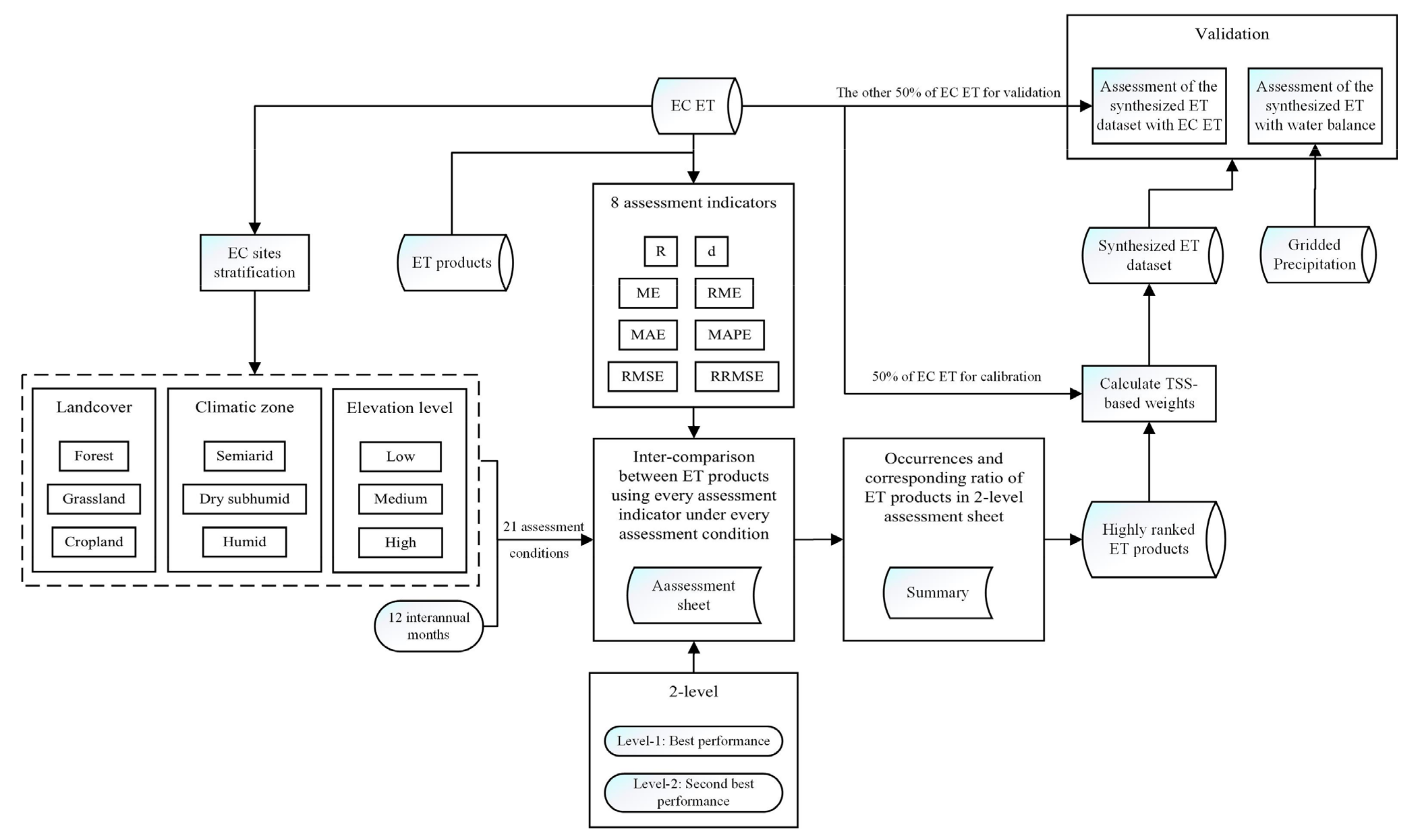
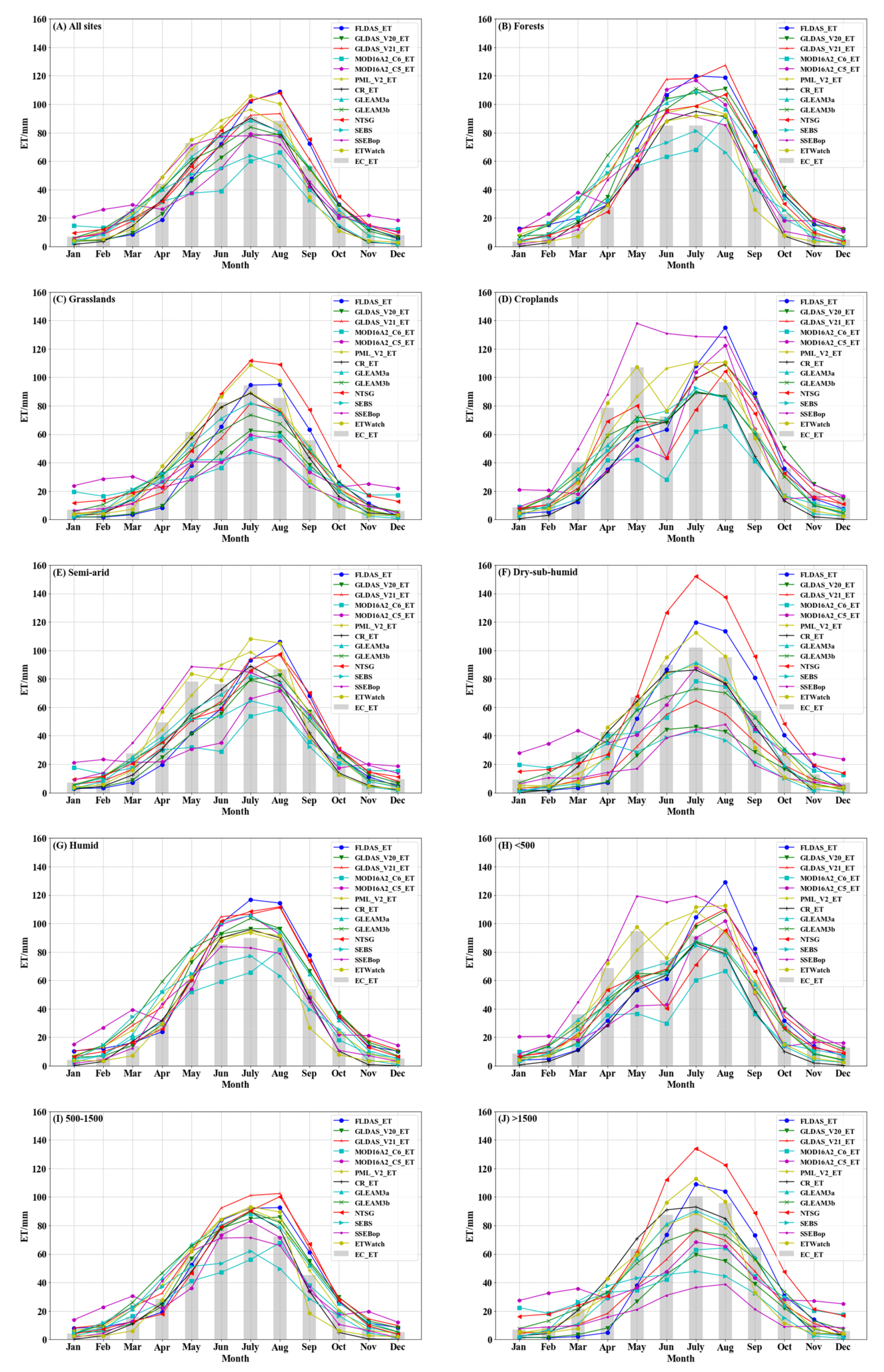
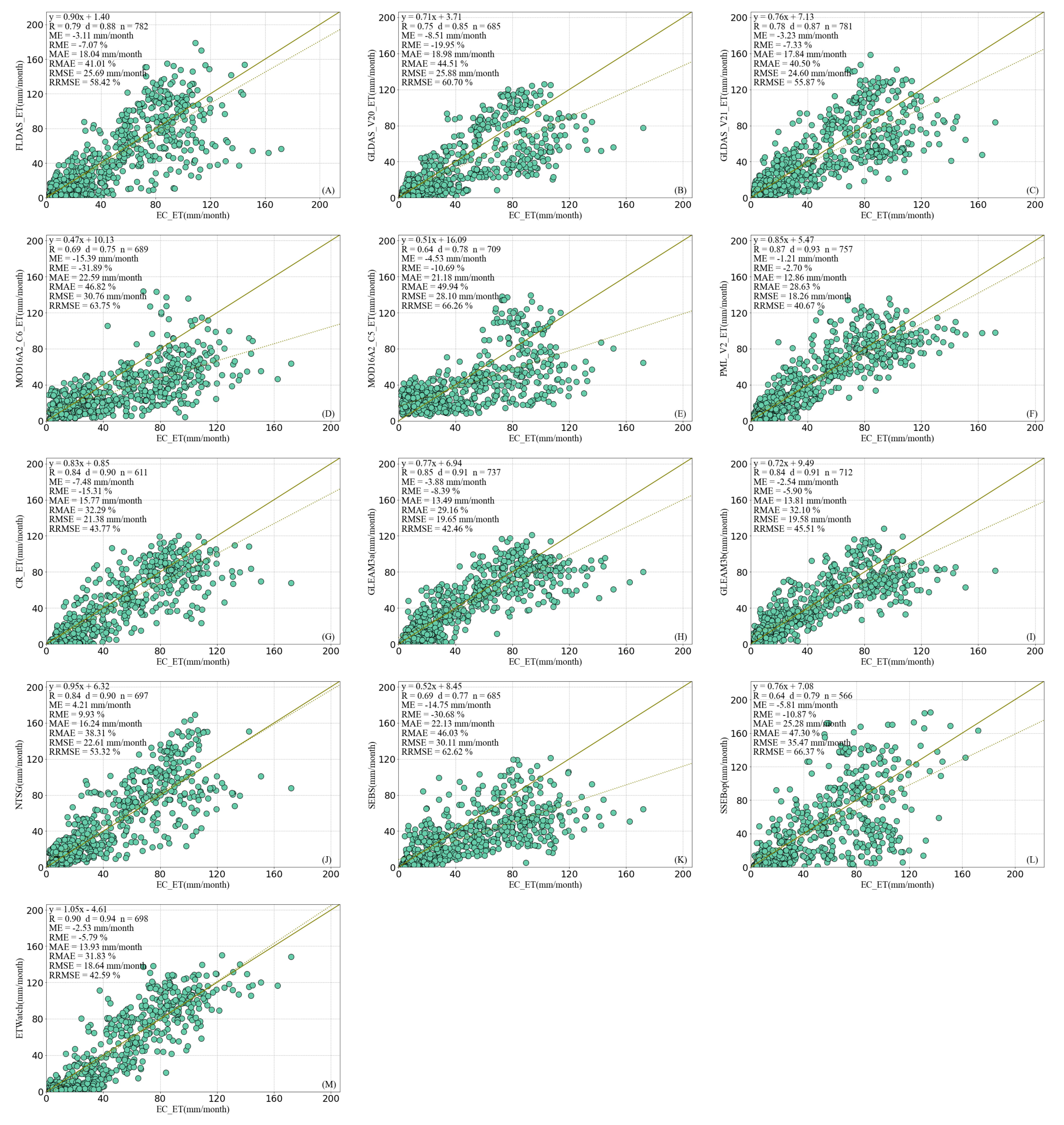

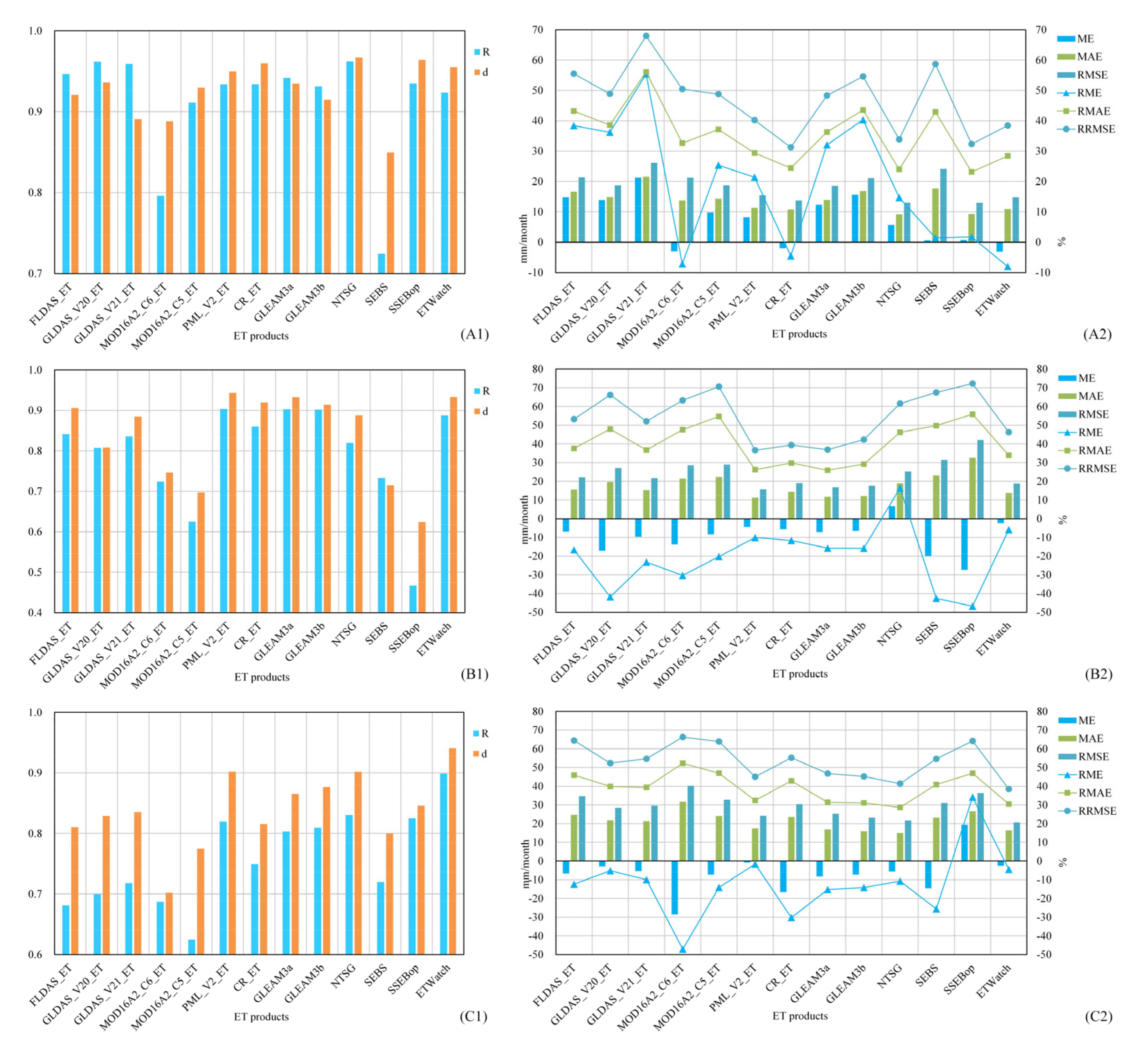


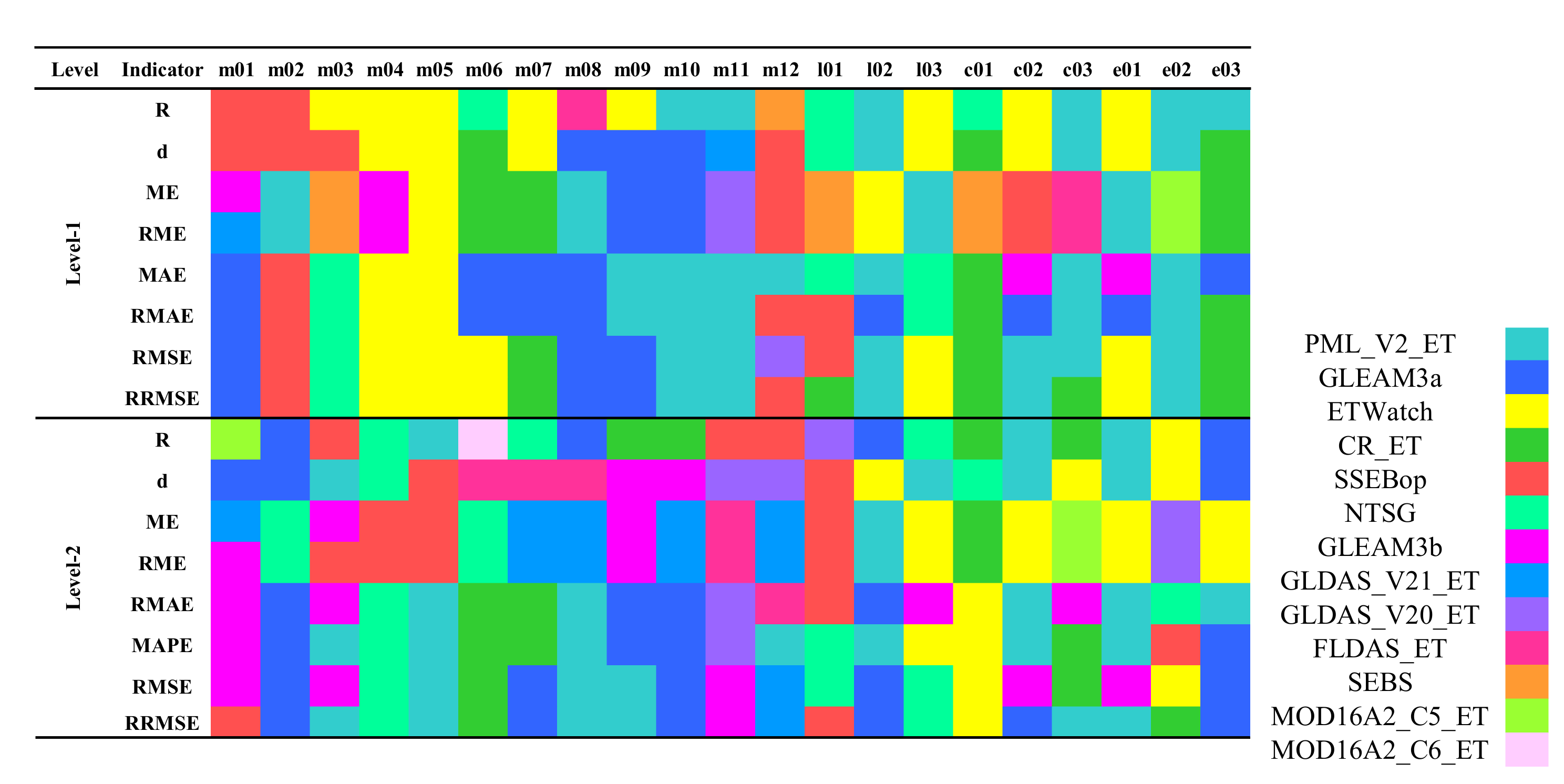


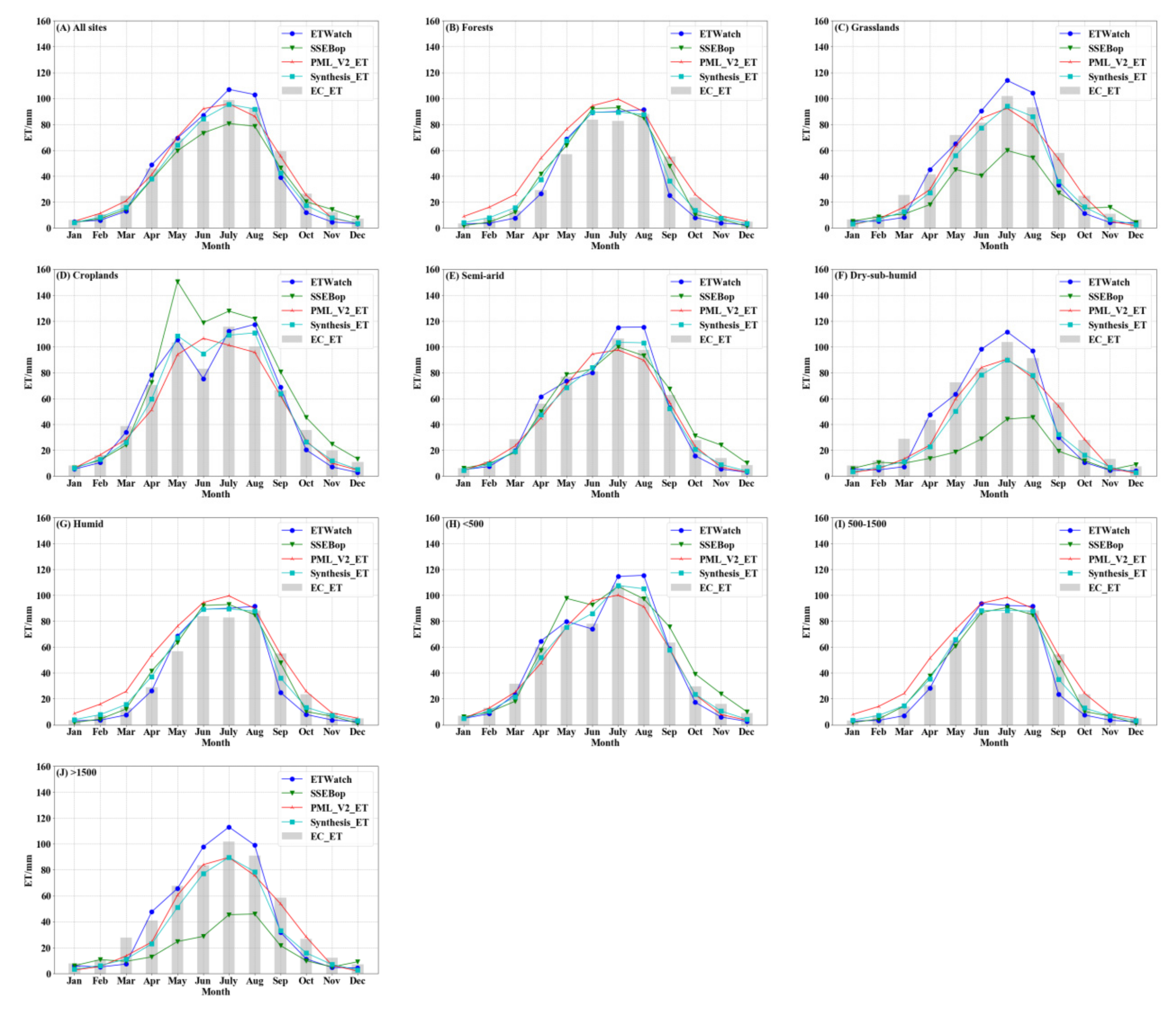




| ET Product | Spatial Resolution | Temporal Resolution | Algorithm | Temporal Range | Reference |
|---|---|---|---|---|---|
| FLDAS_ET | 0.1° | monthly | Noah-3.6.1 | 1982/01/01–present | McNally et al., 2017 |
| GLDAS_V20_ET | 0.25° | 3-h | Noah-3.6 | 1948/01/01–2010/12/31 | Rodell et al., 2004 |
| GLDAS_V21_ET | 0.25° | 3-h | CLSM-F2.5 | 2000/01/01–present | |
| MOD16A2_C6_ET | 500 m | 8-day | P-M/surface conductance model | 2001/01/01–present | Running et al., 2017 |
| MOD16A2_C5_ET | 1000 m | 8-day | 2000/01/01–2014/12/31 | Mu et al., 2013 | |
| PML_V2_ET | 500 m | 8-day | P-M/water-carbon coupled canopy conductance model | 2002/07/04–2017/12/27 | Zhang et al., 2019 |
| CR_ET | 0.1° | monthly | P-T/Complementary Relationship | 1982/01/01–2015/12/31 | Ma et al., 2019 |
| GLEAM 3.3a | 0.25° | daily | P-T/soil stress factor | 1980/01/01–2018/12/31 | Miralles et al., 2011b, Brecht et al., 2016 |
| GLEAM 3.3b | 0.25° | daily | 2003/01/01–2018/12/31 | ||
| NTSG | 8 km | monthly | modified P-M & P-T/biome-specified canopy conductance model | 1982/01/01–2013/12/31 | Zhang et al., 2010b |
| SEBS | 0.05° | monthly | P-M/Surface Energy balance | 2000/04/01–2017/06/30 | Chen et al., 2019b |
| SSEBop | 1000 m | monthly | P-M/simplified Surface Energy balance | 2003/01/01–present | Senay et al., 2013a |
| ETWatch | 1000 m | daily | P-M/Surface Energy balance | 2000/01/01–2017/12/31 | Wu et al., 2020 |
| Site/Station Name | Underlying Surface Type in IGBP Code | Data Start Year | Data End Year | Provider |
|---|---|---|---|---|
| Changbaishan Site (CBS) | MF | 2003 | 2005 | AsiaFlux |
| Haibei Potentilla fruticisa bosk Site (HBG) | GRA | 2003 | 2004 | AsiaFlux |
| Qinghai Flux Research Site (QHB) | GRA | 2002 | 2004 | AsiaFlux |
| Yuchen Site (YCS) | CRO | 2003 | 2005 | AsiaFlux |
| Forest Ecosystem Open Research Station of Changbai Mountains (CBF) | MF | 2006 | 2010 | ChinaFlux |
| Dangxiong flux observation site (DXG) | GRA | 2004 | 2010 | ChinaFlux |
| Daxing site (DX) | CRO | 2016 | 2017 | AIRCAS |
| Guantao site (GT) | CRO | 2016 | 2017 | AIRCAS |
| Haibei alpine meadow ecosystem flux observation station (HBG) | GRA | 2005 | 2010 | ChinaFlux |
| Huailai Site (HL) | CRO | 2013 | 2015 | AIRCAS |
| Miyun Site (MY) | CRO | 2016 | 2017 | AIRCAS |
| Xilingol temperate grassland ecosystem research station (NMG) | GRA | 2004 | 2010 | ChinaFLux |
| Flux observation site of Yucheng warmer temperate dry farming cropland (YCA) | CRO | 2003 | 2010 | ChinaFLux |
| Changling Site (CN-Cng) | GRA | 2007 | 2010 | FluxNET |
| Duolun grassland site (CN-Du2) | GRA | 2006 | 2008 | FluxNET |
| Duolun degraded meadow site (CN-Du3) | GRA | 2009 | 2010 | FluxNET |
| Haibei Alpine Tibet site (CN-HaM) | GRA | 2002 | 2004 | FluxNET |
| Laoshan Site (LSH) | DNF | 2002 | 2002 | AsiaFlux |
| Stratification | Description | Record Number | Proportion (%) | |
|---|---|---|---|---|
| Climatic zones | 0.2 ≤ AI < 0.5 | Semiarid | 491 | 63 |
| 0.5 ≤ AI < 0.65 | Dry subhumid | 124 | 16 | |
| AI > 0.65 | Humid | 167 | 21 | |
| Land cover types | DNF, MF | Forest | 135 | 17 |
| GRA | Grassland | 451 | 58 | |
| CRO | Cropland | 196 | 25 | |
| Elevation levels | Elevation < 500 m | Low | 266 | 34 |
| 500 m ≤ Elevation < 1500 m | Medium | 240 | 31 | |
| Elevation > 1500 m | High | 276 | 35 |
| Year | Precipitation (mm) | Synthesis_ET (mm) | Bias (%) | GLEAM v3.3a (mm) | Bias (%) | NTSG (mm) | Bias (%) | CR_ET (mm) | Bias (%) |
|---|---|---|---|---|---|---|---|---|---|
| 1982 | 137.0 | 136.7 | −0.3 | 118.3 | −13.7 | 153.5 | 12.1 | 139.5 | 1.9 |
| 1983 | 168.8 | 123.9 | −26.6 | 103.7 | −38.5 | 142.8 | −15.4 | 126.6 | −25.0 |
| 1984 | 135.9 | 117.2 | −13.8 | 91.4 | −32.8 | 134.4 | −1.1 | 127.5 | −6.2 |
| 1985 | 127.7 | 116.4 | −8.9 | 81.9 | −35.9 | 135.0 | 5.7 | 134.6 | 5.4 |
| 1986 | 131.5 | 145.3 | 10.5 | 102.8 | −21.8 | 166.6 | 26.7 | 169.2 | 28.7 |
| 1987 | 134.9 | 126.5 | −6.2 | 100.6 | −25.5 | 142.4 | 5.6 | 138.3 | 2.5 |
| 1988 | 151.2 | 124.8 | −17.4 | 97.0 | −35.8 | 137.2 | −9.2 | 142.1 | −6.0 |
| 1989 | 147.0 | 147.2 | 0.1 | 106.1 | −27.9 | 163.0 | 10.9 | 175.1 | 19.1 |
| 1990 | 155.3 | 140.3 | −9.7 | 109.5 | −29.5 | 152.9 | −1.6 | 160.7 | 3.4 |
| 1991 | 126.4 | 133.4 | 5.6 | 104.1 | −17.6 | 148.4 | 17.4 | 149.8 | 18.5 |
| 1992 | 145.7 | 126.1 | −13.4 | 109.6 | −24.8 | 127.0 | −12.8 | 142.6 | −2.1 |
| 1993 | 172.9 | 138.8 | −19.8 | 121.6 | −29.7 | 146.9 | −15.1 | 149.1 | −13.8 |
| 1994 | 133.6 | 144.1 | 7.9 | 109.9 | −17.7 | 158.2 | 18.4 | 166.6 | 24.7 |
| 1995 | 155.9 | 134.3 | −13.9 | 105.7 | −32.2 | 141.6 | −9.2 | 157.2 | 0.8 |
| 1996 | 145.5 | 129.0 | −11.4 | 102.5 | −29.5 | 134.6 | −7.5 | 151.4 | 4.1 |
| 1997 | 113.2 | 133.8 | 18.2 | 85.0 | −25.0 | 129.2 | 14.1 | 190.0 | 67.8 |
| 1998 | 165.9 | 150.9 | −9.1 | 116.9 | −29.6 | 159.8 | −3.7 | 178.2 | 7.4 |
| 1999 | 150.2 | 141.7 | −5.7 | 111.2 | −26.0 | 154.4 | 2.8 | 161.5 | 7.5 |
| 2000 | 131.9 | 144.7 | 9.7 | 107.3 | −18.7 | 177.8 | 34.8 | 151.9 | 15.1 |
| 2001 | 122.2 | 140.1 | 14.7 | 103.2 | −15.5 | 172.5 | 41.2 | 147.4 | 20.7 |
| 2002 | 143.5 | 152.7 | 6.4 | 137.6 | −4.1 | 177.1 | 23.4 | 144.6 | 0.8 |
| Average | 142.7 | 135.6 | −4.0 | 106.0 | −25.3 | 150.2 | 6.5 | 152.6 | 8.3 |
| Year | Precipitation (mm) | Global_Synthesis_ET (mm) | Bias (%) | Synthesis_ET (mm) | Bias (%) | Synthesis_ET_Simple_Mean (mm) | Bias (%) |
|---|---|---|---|---|---|---|---|
| 1982 | 137.0 | 108.4 | −20.9 | 137.1 | 0.1 | 136.7 | −0.3 |
| 1983 | 168.8 | 110.2 | −34.7 | 124.4 | −26.3 | 123.9 | −26.6 |
| 1984 | 135.9 | 101.5 | −25.3 | 117.8 | −13.4 | 117.2 | −13.8 |
| 1985 | 127.7 | 104.4 | −18.3 | 117.2 | −8.3 | 116.4 | −8.9 |
| 1986 | 131.5 | 103.1 | −21.6 | 146.2 | 11.2 | 145.3 | 10.5 |
| 1987 | 134.9 | 109.1 | −19.1 | 127.1 | −5.8 | 126.5 | −6.2 |
| 1988 | 151.2 | 108.9 | −28.0 | 125.4 | −17.0 | 124.8 | −17.4 |
| 1989 | 147.0 | 107.8 | −26.7 | 148.1 | 0.7 | 147.2 | 0.1 |
| 1990 | 155.3 | 109.5 | −29.5 | 141.0 | −9.2 | 140.3 | −9.7 |
| 1991 | 126.4 | 105.0 | −16.9 | 134.1 | 6.1 | 133.4 | 5.6 |
| 1992 | 145.7 | 104.6 | −28.2 | 126.4 | −13.2 | 126.1 | −13.4 |
| 1993 | 172.9 | 113.7 | −34.2 | 139.2 | −19.5 | 138.8 | −19.8 |
| 1994 | 133.6 | 111.0 | −16.9 | 144.9 | 8.4 | 144.1 | 7.9 |
| 1995 | 155.9 | 105.5 | −32.3 | 134.8 | −13.5 | 134.3 | −13.9 |
| 1996 | 145.5 | 110.3 | −24.2 | 129.5 | −11.0 | 129.0 | −11.4 |
| 1997 | 113.2 | 104.4 | −7.8 | 134.7 | 19.0 | 133.8 | 18.2 |
| 1998 | 165.9 | 110.0 | −33.7 | 151.6 | −8.6 | 150.9 | −9.1 |
| 1999 | 150.2 | 108.1 | −28.1 | 142.4 | −5.2 | 141.7 | −5.7 |
| 2000 | 131.9 | 118.5 | −10.2 | 145.7 | 10.4 | 144.7 | 9.7 |
| 2001 | 122.2 | 102.8 | −15.8 | 141.0 | 15.4 | 140.1 | 14.7 |
| 2002 | 143.5 | 124.3 | −13.4 | 153.1 | 6.7 | 152.7 | 6.4 |
| Average | 142.7 | 108.6 | −23.1 | 136.3 | −3.5 | 135.6 | −4.0 |
Publisher’s Note: MDPI stays neutral with regard to jurisdictional claims in published maps and institutional affiliations. |
© 2021 by the authors. Licensee MDPI, Basel, Switzerland. This article is an open access article distributed under the terms and conditions of the Creative Commons Attribution (CC BY) license (http://creativecommons.org/licenses/by/4.0/).
Share and Cite
Wang, L.; Wu, B.; Elnashar, A.; Zeng, H.; Zhu, W.; Yan, N. Synthesizing a Regional Territorial Evapotranspiration Dataset for Northern China. Remote Sens. 2021, 13, 1076. https://doi.org/10.3390/rs13061076
Wang L, Wu B, Elnashar A, Zeng H, Zhu W, Yan N. Synthesizing a Regional Territorial Evapotranspiration Dataset for Northern China. Remote Sensing. 2021; 13(6):1076. https://doi.org/10.3390/rs13061076
Chicago/Turabian StyleWang, Linjiang, Bingfang Wu, Abdelrazek Elnashar, Hongwei Zeng, Weiwei Zhu, and Nana Yan. 2021. "Synthesizing a Regional Territorial Evapotranspiration Dataset for Northern China" Remote Sensing 13, no. 6: 1076. https://doi.org/10.3390/rs13061076
APA StyleWang, L., Wu, B., Elnashar, A., Zeng, H., Zhu, W., & Yan, N. (2021). Synthesizing a Regional Territorial Evapotranspiration Dataset for Northern China. Remote Sensing, 13(6), 1076. https://doi.org/10.3390/rs13061076









